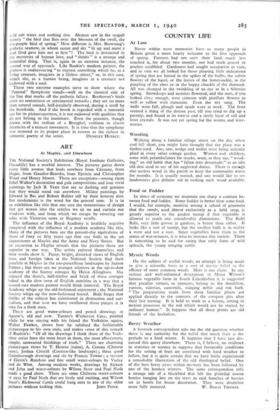ART
At Maples, and Elsewhere
THE National Society's Exhibition (Royal Institute Galleries, Piccadilly) has a morbid interest. The pictures patter down every little avenue that leads nowhere from Cezanne, from Degas, from Gaudier-Brzeska, from Epstein and Christopher Wood and Henry Moore. There are exceptions—among them Ethel Walker's decoration and pale compositions and four vivid paintings by Jack B. Yeats that are so dashing and genuine that they would stand out anywhere. Milder paintings by Edward le Bas and Robert Buhler tell by their honesty also. But modernistic is the word for the general tone. It is in an exhibition like this that one sees the mannerisms of design that get woven into the textiles we sit on and curtain our windows with, and from which we escape by covering our sofas with Victorian roses or Regency scrolls.
The influence of the Royal Academy is healthily negative compared with the influence of a modem academy like this. Many of the pictures here are the present-day equivalents of those of forty or fifty years ago that one finds in the art departments at Maples and the Army and Navy Stores. But an excursion to Maples reveals that the pictures there are superior in one way. The artists enjoyed themselves and their works show it. Fussy, bright, distorted views of English trees and foreign lakes at the National Society find their parallels at Maples in the too-punctilious landscapes by Sutton Palmer ; but there are no younger relatives at the up-to-date academy of the Surrey cottages by Helen Allingham. She enjoyed the thatch, half-timber and brick of these cottages baked in the slow oven of English sunshine in a way that a second-rate modem painter would think immoral. The Royal Academy whips up the old-fashioned enjoyment ; the National Society whips up the new-fashioned hatred. Both forget that dislike of the subject has culminated in abstraction and sur- realism, and that now we have swallowed those purges it is time for a fresh start.
There are good water-colours and pencil drawings at Agnew's, old and new. Turner's Wethercot Cave, painted while he was staying with his friend the Yorkshire squire, Walter Fawkes, shows how he subdued the fashionable picturesque to his own ends, and makes sense of this remark of Rusldn's: " Of all the drawings I think those of the York- shire series have the most heart in them, the most affectionate, simple, unwearied finishings of truth." There are charming picturesque views by T. Hearne (ruins), A. Cozens (Chinese taste), Joshua Cristall (Cotman-like landscape) ; three good Gainsborough drawings and six by Francis Towne ; a version of Girtin's Rainbow and fine small water-colours by Varley and de Wint. Among modern works, drawings by Sickert and John and water-colours by Wilson Steer and Paul Nash made a good show. There are some Chilterns water-colours of 1922 by Paul Nash that are lively and exciting, and Wilson Steer's Richmond Castle could hang next to any of the older pictures without looking thin. JOHN PIPER.














































 Previous page
Previous page